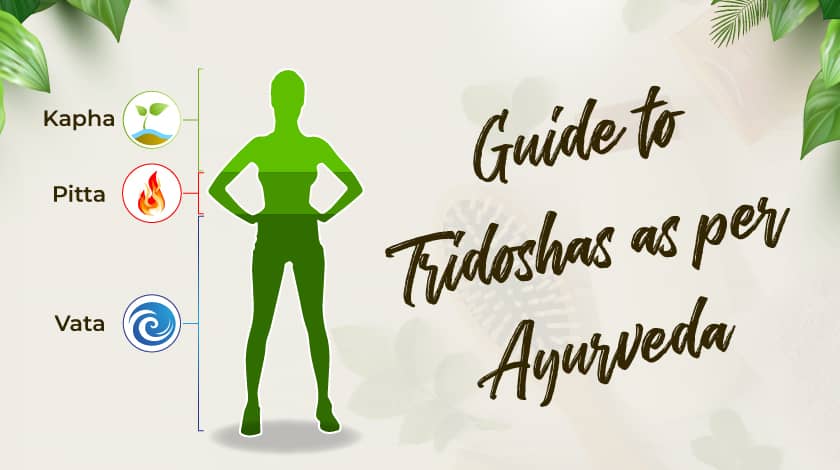Vata, Pitta, Kapha Dosha: Characteristics, Symptoms, Remedies!

As per Ayurveda, the human body is made up of 13 structural and functional components that support bodily functions and contribute to health in their own ways. These are:
- Tridoshas (3 fundamental energies): Vata (energy of movement), Pitta (energy of digestion and metabolism), Kapha (energy of lubrication and structure).
- Saptha Dhatus (7 body tissues): Rasa (blood plasma), Rakta (blood tissue), Mamsa (muscle tissue), Meda (fat tissue), Majja (bone marrow), Sukhram (reproductive system), Asthi (bone tissue).
- Trimalas (3 excreta/types of waste): Mutra (urine), Purusha (stool), Sweda (sweat).
The Doshas, Dhatus, and Malas are a part of the ‘Panchamahabhuta Vikaras’ or derivatives of the five elements of nature because each of them is formed by permutation and combination of the Panchamahabhuta - Akash (space), Vayu (air), Prithvi (earth), Jalam (water), Agni (fire).
In this blog, we will discuss in detail about what exactly are Tridoshas, their characteristics, identifying symptoms, and effects on the human body. We will also cover the aspects of how the Panchamahabhuta, Ritu (seasons), and Shadrasas (types of taste) affect the doshas, and what you can do to reduce (or resolve) any imbalance in the Vata, Pitta, or Kapha dosha.
What are Tridoshas?
As per Ayurveda, the ‘Tridoshas’ (three fundamental energies that govern bodily functions) are distinguished by a set of characteristics that support its particular energy and have a very specific set of functional roles to play in the body.
When Vata, Pitta, and Kapha (collectively referred to as the ‘Tridoshas’) are in equilibrium, it is called ‘Samya Avasta’ - this is good for the body. Any imbalance in any of the Tridoshas can wreak havoc on your health.
Dosha imbalances are commonly caused by an unbalanced diet and unhealthy lifestyle, as well as stress or emotional trauma. These disruptions tend to damage one's normal state of internal equilibrium in the body. The different Ritus (seasons) as well as Shadrasas (types of taste) also have an effect on the Tridoshas and can throw them off balance n specific combinations (as explained below).
Hence, it is essential to identify the right Dosha as given below and find the right fix to get your energies back into balance.
Vata Dosha (Wind Energy)
Vata dosha is the energy of movement that regulates (or governs) all the biological activities of the human body, including movements of the body and mind, breathing, sensory impulses and motor regulation, speech, pumping of the heart, and removal of waste.
It is also called the ‘King of Doshas’ as it gives motion to the other two doshas, Pitta and Kapha.
#1 Characteristics of Vata Dosha
-
Panchamahabhuta Elements: Akash (space) and Vayu (air).
-
Location in the body: Below navel to the bottom (large intestine, pelvic area, knees, skin, ears and hips).
-
Qualities of a Vata-dominant person: active, exceptionally creative, naturally expressive and communicative, lively and fun personality, quick learners, full of joy and enthusiasm.
-
Age of Occurence (Vata Imbalance): Old age.
-
Most Dominant Time: Evening to Night
-
Season of Most Occurrence: Varsha (monsoon) - mid-July to mid-September
#2 Symptoms & Effects of Vata Imbalance
Strong Indications: anxiety, insomnia, flatulence.
General Symptoms:
- Dryness and roughness of skin, hair, lips and joints;
- Bloating, constipation, dehydration, weight loss;
- Dizziness, feeling ungrounded, restlessness;
- Poor blood circulation, muscle spasm or constriction, dry cough, asthma, pain and aches;
- Abnormal bodily movements, fidgeting, agitation, muscle twitching, anxiety, palpitations;
Effects of Vata imbalance during the prevalent season: Weakness, highly sensitive to cold, difficulty in sleeping, irregular appetite and eating habits, prone to stomach difficulties and gas, and poor circulation.
Effects on Jatharagni (digestive fire): appetite problems (feeling both hungry and not hungry).
#3 How to Reduce Vata Imbalance
Home Remedies: Daily Routine
- Follow a regular daily schedule.
- Regulate stress via meditation and other relaxing activities.
- Maintain a warm body temperature during cold weather.
- Take regular massages and bath.
Ayurvedic Remedies: Food
- Consume warm meals and drinks for good health.
- Minimize consumption of raw food.
- Consume sesame oil as it reduces Vata dosha.
- Consume Shadrasas (types of taste) like Meetha (sweet), Khatta (sour), Namkeen (madhura, amla, lavana) as they reduce Vata dosha.
Ayurvedic Treatments: Basti Chikitsa (Therapeutic Enema)
Vata is mostly found in the large intestine; it governs the removal and retention of feces, urine, bile, and other excretions.
In Basti Chikitsa (Therapeutic Enema), the medicated oil or herbal decoction is administered through the anal route. Purusha Dhara Kala, or colon membrane, is connected to Asthi Dhara Kala, or bone tissue membrane. Asthi (the bones) are major Vata dosha locations.
As a result, drugs administered rectally influence all tissues up to the bone tissue.
Pitta Dosha (Fire Energy)
Pitta Dosha is the energy of digestion and metabolism in the body. It works through carrier substances like hormones, organic acids, bile and digestive enzymes.
Pitta provides heat and energy to the body through the breakdown of food molecules and governs all the conversion and transformation processes in the body and mind.
#1 Characteristics of Pitta Dosha
-
Panchamahabhuta Elements: Jalam (water) and Agni (fire).
-
Location of Pitta in the body: From the heart to the navel (stomach, liver, pancreas, small intestines, blood, and eyes).
-
Qualities of a Pitta-dominant person: intelligent and governed by emotions of courage, joy, willpower, anger, jealousy, and metal perception.
-
Age of Occurence (Pitta Imbalance): Middle age.
-
Most Dominant Time: 10am - 2pm.
-
Season of Most Occurrence: Grishma (summer) - mid-May to mid-July
Note: Workaholics are more often prone to Pitta disorders.
#2 Symptoms & Effects of Pitta Imbalance
Strong Indications: feeling emotionally sensitive, perspiring excessively, burping frequently, and hyperacidic metabolism.
General Symptoms:
- Hot and reactionary emotions: frustration, anger, jealousy, irritability, and criticism
- Excess generation of heat in the body, inflammation of the joints
- Acid reflux, gas, indigestion, nausea, diarrhea or constipation
- Bad breath, excessive sweating, body odor
Effects of Pitta imbalance during the prevalent season: Irritable, prone to argument, always hungry, mood swings when hungry, acne and inflammation prone, heat sensitive.
Effects on Jatharagni (digestive fire): Increases digestive fire and metabolism, making you feel more and more hungry.
#3 How to Reduce Pitta Imbalance
Home Remedies: Daily Routine
- Focus on work-life balance.
- Take part in mental challenges and sports.
- Do regular meditation and get sufficient relaxation.
- Sleep for at least seven hours everyday.
- Avoid excessive heat (e.g., weather, spicy food).
Ayurvedic Remedies: Food
- Consume Cow ghee to reduce Pitta dosha.
- Follow appropriate nutrition as per your body type.
- Consume Shadrasas (types of taste) like Kasela, Kadwa, Meeta (tikta, kashaya, madhura) as it reduces Pitta dosha.
Ayurvedic Treatments: Virechana chikitsa (Therapeutic Purgation)
Virechana, also known as vitiated purgation, is the process by which Pitta is eliminated through the anus.
During the Virechana Ayurvedic therapy, the patient will be given Ayurvedic medications orally. Castor oil is also added in amounts ranging from 30-35 ml.
Virechana purifies the blood, sweat glands, kidneys, stomach, small intestine, colon, liver, and spleen. This is a highly recommended therapy for reducing excess pitta dosha.
Kapha Dosha (Water Energy)
Kapha dosha is the energy of structure and lubrication that gives the body its physical form and smooth functioning of all the parts. It aids in lubricating the joints, storing energy and giving bulk to the tissues.
#1 Characteristics of Kapha Dosha
-
Panchamahabhuta Elements: Prithvi (earth) and Jalam (water).
-
Location of Kapha in the body: From head to heart (chest, lungs, throat, head, connective tissues, fatty tissues, ligaments, and tendons).
-
Qualities of a Kapha-dominant person: easy-going, relaxed, compassionate and loving, non-judgemental, do not get upset easily, known to be possessive and hold on to things and people for a long time.
-
Age of Occurence (Kapha Imbalance): Young age.
-
Most Dominant Time: Mornings.
-
Season of Most Occurrence: Vasantha (spring) - mid-March to mid-May
#2 Symptoms & Effects of Kapha Imbalance
Strong Indications: stubbornness, phases of internal withdrawal, lethargy.
General Symptoms:
- Overly sentimental, triggers emotions of attachment, greed, and possessiveness
- Stubbornness, reluctance to change, brain fog and lethargic, difficulty rising in the morning,
- Excess bodily fluids and mucus; thick, white coating on the tongue
- Tendency for “emotional overeating”
- Weight gain and difficult losing weight
- Sticky and sluggish bowel movements
Effects of Kapha Imbalance during the prevalent season: Weight gain, poor metabolism, sluggishness, excessive sleeping, respiratory problems (i.e., asthma, allergies).
Effects on Jatharagni (digestive fire): completely turns off the digestive fire and slows down metabolism.
#3 How to Reduce Kapha Imbalance
Home Remedies: Daily Routine
- Maintain a good diet.
- Keep a warm body temperature.
- Prioritize regular exercise in both physical and spiritual sense.
- Avoid sleeping for long periods during the day.
- Maintain an active lifestyle with good social contacts.
Ayurvedic Remedies: Food
- Consume Honey to reduce Kapha dosha.
- Consume Shadrasas (types of taste) like Tikha, Kadwa, Kaseela (katu, tikta, kashaya) as it reduces Kapha dosha.
Ayurvedic Treatments: Vaman chikitsa (Emesis Therapy)
Vamana Chikitsa, also known as Emesis Therapy, is the controlled, medically induced vomiting. Its goal is to reduce excess Kapha Dosha by expelling waste products or toxins from the body via the oral route.
Emesis treatment cleanses Kapha in the body and decongests the respiratory system, which might otherwise cause a variety of diseases such as acne, asthma, arthritis, and persistent colds.
Conclusion
In conclusion, Ayurveda recognizes the importance of the Tridoshas, Saptha Dhatus, and Trimalas in maintaining bodily functions and promoting overall health. The Tridoshas, specifically Vata, Pitta, and Kapha, have distinct characteristics and roles in the body, and any imbalance can have negative effects on one's health.
Dosha imbalances can be caused by an unhealthy lifestyle, stress, emotional trauma, as well as specific seasons and tastes. It is crucial to identify one's Dosha and take the necessary steps to restore balance.
This blog provides an in-depth understanding of Vata Dosha, its characteristics, symptoms of imbalance, and remedies to reduce it. The remedies include daily routines, Ayurvedic food, and treatments such as Basti Chikitsa. By following these remedies, one can maintain Vata Dosha balance and improve their overall health and well-being.

